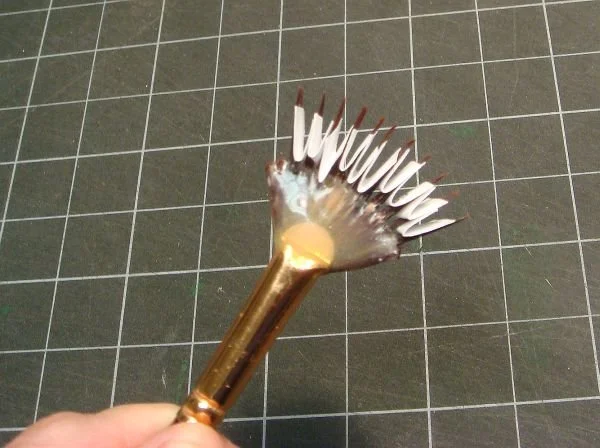Reconstructing and Making Brushes
As an evolution of my interest in the "Rake" brush, I have made many versions of this concept for building layers of textures and building forms and shapes within a painting. You can see the use of these brushes in practically all of my abstract art.
Here are some brushes that I made from combining rounds fit into a homemade wood handle.
For some reason, I have never felt that I could used fan brushes with acrylic paint effectively, so I started to reconstruct them into something more useful to my style.
Here is a quick "how to" if you want to give this a try. Since I have converted all of my fans, this illustration is shown with one of my already altered fans.
About all you need is brush sizing or a strong hair mousse, pallet knife and a five minute two part water proof epoxy. Below, I cut small pieces of paper and fold them.
Next, mousse (styling foam) the brush and begin working the fibers or hairs into sections and insert the folded paper.
Let this dry for several hours or overnight, remove the paper and mix the epoxy. The trickiest part is working the epoxy carefully over ferrule and into the separation of the fibers. You want the epoxy to go completely through fibers to each side of the brush, which requires turning it over several times until the epoxy takes a set.
Recently, I discovered some kraft brushes that were inexpensive at Michael's (arts and crafts store). I noticed they were made by Loew-Cornell which means they probably use taklon, which is a good fiber for acrylics. I used the same procedure from above to create these.
If you notice on the middle brush, I epoxied the top of the ferrule to seal it to the wood for cleaning. I do this with all brushes because eventually, moisture under the ferrule will destroy the wood and rust the ferrule. Even larger expensive watercolor wash brushes (flats) have gaps in the ferrules that need filling and sealing.
Here are some examples using these brushes:
"Yoga" Acrylic on Paper 12”x12"
"Abstract 11" Acrylic 17x23
Sponge Brushes
Sponges are great for adding textural effects to watercolor paintings, and they come in many shapes and textures. I had always kept a variety of sponges around, but tended not to use them because they seemed a bit awkward in their original sizes and shapes. One day I decided to configure a sponge into a more usable “brush” form, and now I find them very effective.
Making a sponge brush is very easy, and only requires a handle, wire (I use thin copper wire), epoxy, and sponges. For the handle, I use old paintbrush handles or wood dowels, and any two-part five-minute epoxy seems to work fine.
As you can see, I’ve made sponge brushes from exotic deep-sea sponges as well as common “kitchen” sponges in a variety of sizes.
Article from SCRIPSIT Vol. 41, Number 1
Washington Calligraphers Guild 2019










